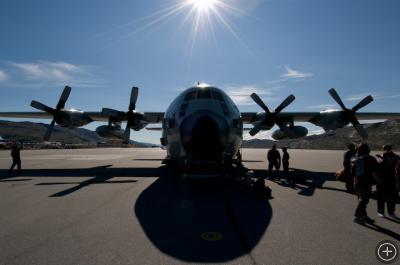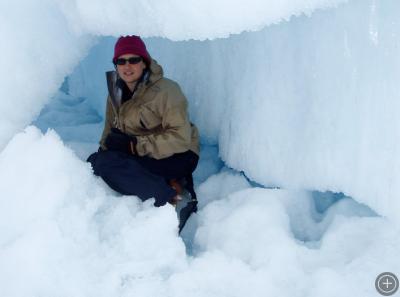Destination: Melting Greenland
EN ROUTE TO KANGERLUSSUAQ, GREENLAND– (Onboard an LC-130 from Stratton National Air Guard Base)
For scientists doing research in Greenland, and those of us lucky enough to tag along with them, actually getting to the field camps is a often a hurry-up-and-wait journey. If you hitch a ride with the Air National Guard like we’re doing, you must first travel to Albany, New York the day before the LC-130 military transport plane flies north (Lisa and I took the red-eye from San Jose, CA two days ago).
The morning of the Greenland flight, we all pile in cabs at 5 AM, head to the air base, get our gear and bodies weighed, then sit around for a few hours while cargo is loaded and the flight crew is preparing the plane. We get a briefing video on how to sit on canvas troop seats (not very comfortably), about the plane’s emergency procedures (the oxygen system is truly alarming: you stick a bag over your head and hope the oxygen flows), and finally board a bus out to our gray-and-black propeller plane (equipped with skis and wheels for landing on snow, sand or regular runways).
One of the nice things about waiting around with scientists is, well, they’re interesting people to hang around and talk with. One of the first people we met at the airport on the way in was Chris Linder from Woods Hole Oceanographic Institution (WHOI). Chris is a photographer with nearly as much gear as us who has been visiting research sites at both poles and posting dispatches for an IPY educational website Polar Discovery. But for the moment, Chris is missing the writer on his team, who won’t be joining him until later. So he’ll be doing double duty taking pictures with his many cameras and writing a blog from a glacier camp near Ilulissat run by WHOI glaciologist Sarah Das.
After wandering around Schenectady, Chris, Lisa and I hooked up with some glaciologists for dinner. In the group was Mark Fahnestock, who studies flow rates of glaciers and tracks iceberg calving events, Ian Joughin who researches ice sheet dynamics, and Ian Howatt, part of a team tracking glacier motion with seismometers, cameras, and other instruments. We got into a discussion about whether outlet glaciers, the tongues of fast-moving ice that have been speeding up over the last decade, represent an early warning that the entire ice sheet may be disintegrating or whether it is a summer-time phenomena that stabilizes in the fall and winter. A recent research paper in Science Magazine, written up in the New York Times, seemed to indicate the latter so I wanted to hear from the assembled experts what they thought.
Turns out, they’re still working on the answer to that. “Science is messy,” Ian Joughin told me. “What we think one month could be overturned by new evidence the next.” Ten years ago, most computer climate models dealt with the ice sheets of Greenland and Antarctica as single massive entities that would slowly melt or grow depending on the temperature. At the time, glaciologists didn’t give reasons to question that dogma. Then researchers discovered that there were lakes and waterways under Antarctica that may be causing the ice sheet to slip and slide along the bed rock. A few years ago, Sarah Das and her colleagues discovered that the large melt-water lakes on top of Greenland’s ice sheet could suddenly crack open a channel to the bedrock and drain in less than two hours, causing the glacier to lurch toward the ocean. Do dramatic events like these increase the likelihood that the ice will disappear completely, could they be an indicator that we’ve reached some kind of tipping point?
That’s what these scientists are all heading on a military plane to Greenland to find out. As a group, glaciologists are a small, but very busy community, and suddenly climate modelers, the media and policy makers are paying much more attention to their work. There is no doubt among the group that summertime warming is melting and speeding up the glaciers and that overall temperatures in Greenland have been increasing over the last 40 years. But exactly how the dynamic ice sheets will respond to warming and how much they’ll contribute to sea level rise is an open question that these polar-bound scientists are on a mission to find out.

 No comments
No comments 










